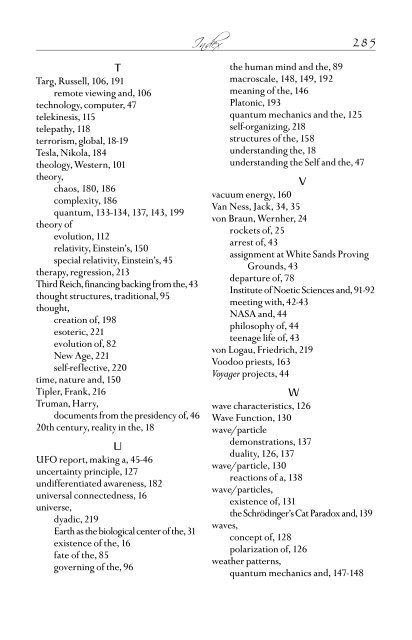edgar-mitchell
edgar-mitchell
edgar-mitchell
Create successful ePaper yourself
Turn your PDF publications into a flip-book with our unique Google optimized e-Paper software.
Invisible Realities 143<br />
The experimenter’s awareness of the cat’s state when opening the box may<br />
have caused the experimenter’s internal map of the wave equation to collapse<br />
and coincide with the alive or dead state. But the experimenter’s<br />
wave equation is only being updated by external information. Garnering<br />
that information does not, by itself, influence the cat’s health, as the pattern<br />
of energy flows from cat to observer. The experimenter might have<br />
become aware through nonlocal means (intuitively), but that still isn’t<br />
causal. Were the experimenter psychokinetically active, we might possibly<br />
influence the apparatus intentionally. Therefore, simply being aware<br />
couldn’t kill the cat, and knowing couldn’t kill the cat. But intending to<br />
might.<br />
In any of its various forms, scientists usually disdain the Idealist position,<br />
which allows the mind to be causal. Yet Schrodinger’s cat has been in<br />
a box with a vial of poison, waiting 75 years for some experimenter to<br />
decide whether or not looking in the box created the coup de grace—<br />
whether or not the probability wave is the same as physical reality. It has<br />
doubtless died of old age by now, regardless of how we think about it.<br />
Physical death, it seems, is inevitable.<br />
An entire body of interpretation of quantum physics has grown from<br />
the Schrödinger’s Cat Paradox. The conundrums sprouted from the perplexity<br />
of the issue and the lack of understanding as to how mind and body<br />
interact (Newton erroneously assumed they don’t interact). An interpretation<br />
of quantum mechanics exists that is really an attempt to get around<br />
the unsettling indeterminacy of quantum theory and the lack of a “picture”<br />
for the underlying reality. This is the Many Worlds interpretation,<br />
and it proposes that all of the probabilities in the wave equations are real.<br />
By simply choosing to open the box and discovering the cat dead or alive,<br />
the experimenter causes the universe to divide into two universes: one<br />
where everything is the same, except the experimenter discovers a dead<br />
cat, and another in which she finds the cat alive. Here the map is actually<br />
the territory.<br />
In this interpretation, each choice we make branches the universe into<br />
the many probabilities available. The one we find ourselves in corresponds<br />
to the choice we made, but the others are presumably equally real. It’s just<br />
that we can’t be aware of them, because they are orthogonal (at a 90°<br />
angle) to our own. This interpretation by physicists is a permutation of the<br />
extreme position of the Idealist model—though some physicists have trouble<br />
admitting as much.<br />
Many Worlds is a flawed concept that unfortunately has yet to be<br />
falsified since it was proposed in the 1960s. I find it both amusing and<br />
absurd that physicists will believe that even casual choices can create entire<br />
universes we can’t see or verify, and must violate conservation laws.


